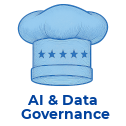Governance Theater vs. Governance by Design: A Tale of Two Companies
Let’s meet two companies.
They’re in the same industry.
They face the same regulatory pressures.
They both just launched governance programs.
But only one of them will see results.
Company A: The Governance Committee Chronicles
Company A knows they need a governance program.
They’ve read the white papers.
They’ve hired a consultant and followed their expensive advice:
- They’ve formed a steering committee with cross-functional representation.
- There’s:
- A charter.
- A RACI.
- A SharePoint folder full of policies.
- Every month, the committee meets.
- They review metrics.
- They discuss definitions.
- They debate ownership.
- They nod in agreement.
But here’s what doesn’t happen:
- No decisions get made.
- No data gets reclassified.
- No AI models get reviewed.
- No business process changes.
The governance program exists.
But it’s not embedded.
It’s not activated.
It’s not trusted.
This is governance theater: structured, well-intentioned, and completely disconnected from business outcomes.
Why?
When you do not have a Governance Lead who understands that business should drive the program, you do not know the right questions to ask.
Company B: Governance by Design
Company B starts differently.
They also hire a consultant – but this time he/she knows the Five Star way – Start with the business.
Before forming a committee, they ask:
“What are our biggest data issues?”
“What are our biggest AI risks or concerns that are holding us back from developing those programs?”
They define three outcomes:
- Transparent oversight of AI models
- Streamlined compliance across jurisdictions
- Operational efficiency through trusted master data
From there, they build backward:
- What decisions must be made to achieve these outcomes?
- What data must be trusted to support those decisions?
- What roles, processes, and tools are needed to activate that trust?
Their governance blueprint isn’t a document—it’s a mechanism.
It maps directly to business priorities.
It defines triggers, thresholds, and accountability.
It’s designed to scale.
The committee still exists.
But now it’s a decision-making body, not a discussion group.
It reviews AI model risk scores.
It signs off on data quality thresholds.
It resolves ownership disputes with authority.
This is governance by design: intentional, outcome-driven, and transformative.
The Takeaway: Structure Is Not Strategy
Both companies “did governance.”
But only one built it to work.
Governance by committee creates the illusion of progress.
Governance by design creates measurable impact.
So before you schedule your next steering committee meeting, ask yourself:
- What outcomes are we trying to achieve?
- What decisions must we support?
- What trust must we enable?
Because governance is not a meeting.
It’s a mechanism.
And it only works when it’s designed to.
Talk to our head Chef to see if the Five Star way can help your program.

